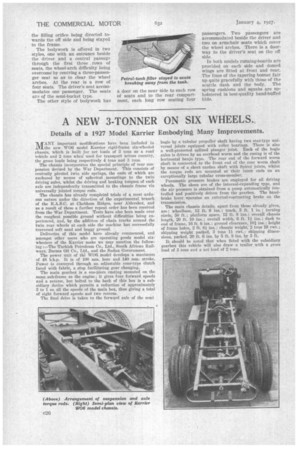A NEW 3-TONNER ON SIX WHEELS.
Page 48

If you've noticed an error in this article please click here to report it so we can fix it.
Details of a 1927 Model Karrier Embodying Many Improvements.
MANY important modifications have been included in the new WO6 model Karrier rigid-frame six-wheeled chassis, which is built for net loads of 3 tons as a road vehicle and 2 tons when used for transport across country, the gross loads being respectively 4 tons and 3 tons.
The chassis incorporates the special principle of rear suspension devised by the War Department. This consists of centrally pivoted twin side springs, the ends of which are anchored by means of spherical mountings to the twin driving axles, whilst the driving and braking torques of each axle are independently transmitted to the chassis frame via universally jointed torque rods.
The chassis has already completed trials of a most .arduous nature under the direction of the experimental branch of the R.A.S.C. at Chobham Ridges, near Aldershot, and as a result of these a further repeat order has been received from the War Department. Tests have also been made over the roughest possible ground without difficulties being experienced, and, by the addition of chain tracks around the twin rear wheels at each side the machine ha S successfully traversed soft sand and boggy ground.
Deliveries of this model have already commenced, and amongst other users who are operating goods model sixwheelers of the Karrier make we may mention the following :—The Turkish Petroleum Co., Ltd., South African Railways, Burma Oil Co., Ltd., and the Sudan Government.
The power unit of thi; W06 model develops a maximum of 48 b.h.p. It is of 100 Jam. bore and 140 mm. stroke. Power is conveyed through an adjustable cone-type clutch faced with fabric, a stop facilitating gear changing.
The main gearbox is a one-piece casting mounted on the same sub-frame as the engine; it gives four forward speeds and a reverse, but bolted to the back of this box is a subsidiary device which permits a reduction of approximately 3 to 1 on all the speeds of the main box, thus giving a total of eight forward speeds and two reverse.
The final drive is taken to the forward axle of the semi bogie by a tubular propeller shaft having two star-type universal joints equipped with roller bearings. There is also a well-protected splined plunger joint. Each of the bogie axles is driven by an overhead worm and the casing is of the horizontal banjo type. The rear end of the forward worm shaft is connected to the front end of the rear worm shaft by means of a short cardau shaft with Spicer joints, whilst the torque rods are mounted at their inner ends on an exceptionally large tubular cross-member.
Pneumatic pressure brakes are employed for all driving wheels. The shoes are of the internal-expanding type, and the air pressure is obtained from a pump automatically controlled and positively driven from the gearbox. The handbrake lever -operates an external-contracting brake on the transmission.
The main chassis details, apart from those already given, are: wheelbase, 12 ft. 6 ins.; track, 5 ft. 1 in.; turning circle, 50 ft.; platform space. 12 ft. 8 ins.; overall chassis length, 20 ft. 10 ins.; overall width, 6 ft. n ins.; dash to end of frame, 16 ft. 6 ins.; ground cream:ice, 101 ins.; height of frame laden, 2 ft. 8i ins.; chassis weight; 2 tons 19 cwt.; shipping weight packed, 3 tons 11 cwt.; shipping dimensions, packed, 20 ft. 6 ins. by 5 ft. 8 ins. by 3 ft.
It should be noted that when fitted with the subsidiary gearbox this vehicle will also draw a trailer with a gross load of 3 tons and a net load of 2 tons.












































































































